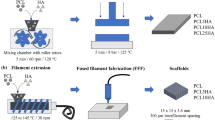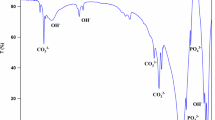Abstract
A variety of bioactive composites have been developed for tissue replacement over the last two decades. In this investigation, a new material consisting of hydroxyapatite (HA) and polysulfone (PSU) was produced and evaluated for potential medical applications. The HA/PSU composite containing up to 20 vol % of HA was studied at the initial stage. It was manufactured via a standardized procedure which included drying, blending, compounding and injection/compression molding. Defect-free composite samples (rectangular bars, discs and dumbbell specimens) could be obtained by injection molding. Thick composite plates could be made by compression molding. Both compounded materials and molded parts were assessed using a variety of techniques. It was found through scanning electron microscopy (SEM) that HA particles were well dispersed in the PSU matrix. Thermogravimetric analysis (TGA) verified the amount of HA in the composite. Differential scanning calorimetry (DSC) results indicated that the glass transition temperature (Tg) of the polymer matrix was not affected by the incorporation of HA. Rheological analysis revealed that PSU and the composite exhibited pseudoplastic behavior. For unfilled PSU, its viscosity decreased with an increase in temperature. The viscosity of HA/PSU composite increased with an increase in the HA volume fraction. It was shown through dynamic mechanical analysis (DMA) that the storage modulus of the composite was increased with an increase in HA volume percentage below Tg of the polymer, while tan δ was maintained at nearly the same level. It was established that water uptake reached an equilibrium after 7 days' immersion in distilled water for PSU and HA/PSU composite. After 7 days' immersion in distilled water, the storage modulus of the composite was decreased less than that of PSU. © 2001 Kluwer Academic Publishers
Similar content being viewed by others
References
W. Bonfield, M. D. Grynpas, A. E. Tully, J. Bowman and J. Abram, Biomaterials 2 (1981) 185-186.
W. Bonfield, M. D. Grynpas and J. A. Bowman, UK Patent GB2085461B (1984).
C. Doyle, E. T. Tanner, and W. Bonfield, Biomaterials 12 (1991) 841-847.
M. Wang, W. Bonfield and L. L. Hench, Bioceramics 8 (1995) 383-388.
M. Wang, W. Bonfield and T. Kokubo, Bioceramics 9 (1996) 387-390.
R. L. Orefice, G. P. Latorre, J. K. West and L. L. Hench, Bioceramics 8 (1995) 409-414.
K. I. Clarke, S. E. Graves, A. T. C. Wong, J. Triffitt, M. J. O. Francis and J. T. Czernuszka, J. Mater. Sci. Mater. Med. 4 (1993) 107-110
J. Wolff, Das Gesetz der Transformation der Knochen, (Hirschwald, Berlin, 1892) (Reprinted in English translation, Springer-Verlag, 1987).
W. Bonfield, M. Wang and K. E. Tanner, Acta Mater. 46 (1998) 2509-2518.
M. Wang, C. Berry, M. Braden and W. Bonfield, J. Mater. Sci. Mater. Med. 9 (1998) 621-624.
M. Wang, R. Joseph and W. Bonfield, Biomaterials 19 (1998) 2357-2366.
M. Wang, S. Deb, K. E. Tanner and W. Bonfield, Proceedings of the Seventh European Conference on Composite Materials, London, UK, 2 (1996) 455-460.
M. Wang, I. M. Ward and W. Bonfield, Proceedings of the Eleventh International Conference on Composite Materials, Gold Coast, Australia, 1 (1997) 488-495.
J. Huang, L. Di Silvio, M. Wang, K. E. Tanner and W. Bonfield, J. Mater. Sci. Mater. Med. 8 (1997) 775-779.
Z. B. Luklinska and W. Bonfield, in “Bonc-bonding Biomaterials”, edited by P. Ducheyne, T. Kokubo and C. A. van Blitterswijk (Reed Healthcare Communications, The Netherlands, 1992).
R. N. Downs, S. Vardy, K. E. Tanner and W. Bonfield, Bioceramics 4 (1991) 239-246.
W. Bonfield, Bioceramics 11 (1998) 37-40.
S. H. Teoh, Z. G. Tang and G. W. Hastings, in “Handbook of Biomaterial Properties”, edited by J. Black and G. Hastings (Chapman and Hall, London, 1998).
M. Wang, D. Porter and W. Bonfield, Br. Ceram. Trans. 93 (1994) 91-95.
M. J. Edirisinghe and J. R. G. Evens, J. Mater. Sci. 22 (1987) 269-277.
M. J. Edirisinghe and J. R. G. Evens, Br. Ceram. Trans. 86 (1987) 18-22.
D. A. Issitt and P. J. James, Powder Metallurgy 29 (1986) 259-263.
Author information
Authors and Affiliations
Corresponding author
Rights and permissions
About this article
Cite this article
Wang, M., Yue, C.Y. & Chua, B. Production and evaluation of hydroxyapatite reinforced polysulfone for tissue replacement. Journal of Materials Science: Materials in Medicine 12, 821–826 (2001). https://doi.org/10.1023/A:1017933220894
Issue Date:
DOI: https://doi.org/10.1023/A:1017933220894




